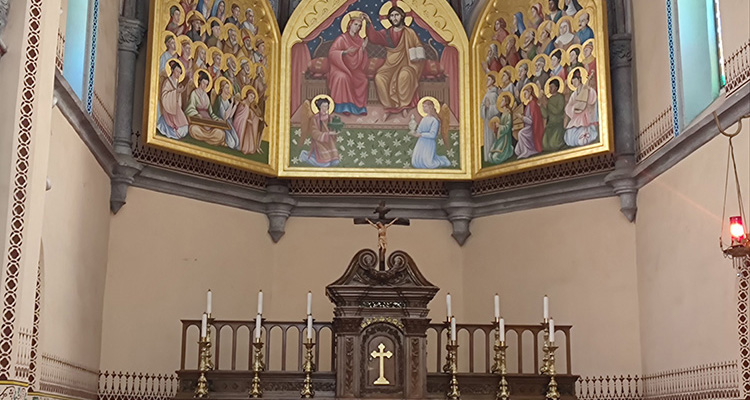Xizhimen Catholic Church: Exploring Beijing’s Historic Gothic Church
At a bustling street corner in Beijing’s Xizhimen area, a gray-brick building quietly stands. This is Xizhimen Church (also known as the Church of the Holy Mother’s Vestments), one of the oldest Catholic churches in Beijing. Unlike the more famous Wangfujing Church, it offers a unique architectural aesthetic and a peaceful atmosphere, making it one of the best places to experience Beijing’s multicultural heritage.
1. Why It’s a Unique Cultural Landmark in Beijing
The history of Xizhimen Church dates back to 1723 (the first year of Emperor Yongzheng), built by the Italian missionary Father Delige. The current building was reconstructed in 1912 and is one of the most distinctive of Beijing’s four major Catholic churches. It belongs to the Beijing Catholic Diocese and serves as a key center for Catholic activities in western Beijing.
Its uniqueness lies in the fusion of Eastern and Western architectural styles. The church maintains the solemnity and sanctity of Western churches while incorporating the subtle elegance of Chinese architectural elements. For local Beijingers, it is not only a place of worship but also a living witness to centuries of cultural exchange. During Christmas, the church bells harmonize intriguingly with the surrounding urban bustle, reflecting Beijing’s inclusive character.

2. Architectural Art and Spatial Experience
Architectural Style and Symbolism
Xizhimen Church combines Romanesque and Gothic styles while cleverly integrating Chinese brick carving techniques. The façade follows typical Western church design but features gray bricks and tiles characteristic of Beijing. The bell tower on top is particularly striking, functional in Western style but adorned with subtle Chinese decorative details.
Inside, the church follows a Latin cross layout, symbolizing Christ’s crucifixion. Though the interior is not large, its stained-glass windows and thoughtful spatial arrangement create a solemn and sacred atmosphere. When sunlight passes through the stained glass, it casts colorful patterns on the walls and floor, generating a highly spiritual environment.
Art Treasures and Religious Significance
The church’s most valuable artworks include the statue of the Holy Mother’s Vestments above the altar and the fourteen Stations of the Cross along the sides. Most of these sculptures date from the late Qing to early Republic periods, blending Western realism with the subtle elegance of Eastern art. The stained-glass windows depict biblical stories, narrating ancient religious tales through shifting light and shadows.

3. Visitor Guide: How to Fully Experience the Church
Recommended Tour Route and Duration
A visit of around 1 hour is suggested:
- Start at the church plaza, observing the fusion of Eastern and Western architectural details.
- Enter through the main door and pause briefly to experience the transition into sacred space.
- Walk along the central axis, appreciating the stained-glass windows and Stations of the Cross.
- Sit quietly before the altar, enjoying the changing light and serene atmosphere.
- Finish in the church garden at the back for a moment of reflection.
Best Visiting Time
Weekday afternoons are ideal when crowds are light, and sunlight through the western stained glass produces the most beautiful light effects. For a more immersive religious experience, attend a Sunday morning Mass.
Language Services
The church provides Chinese guided tours, and English brochures are available for free at the entrance. Staff can communicate in basic English to assist foreign visitors.

4. Visitor Guidelines: Respect and Etiquette
Dress Code and Behavior
Wear modest clothing, avoiding tank tops and shorts. Maintain quietness inside the church, and set your phone to silent mode. Photography is not allowed without permission, especially during religious services.
Participation in Religious Activities
Mass schedule:
- Weekdays: 7:00 AM
- Sundays: 6:30 AM and 8:30 AM (English Mass)
Visitors may attend any Mass but should arrive 15 minutes early and observe proper etiquette. Non-believers may sit in the back and watch without moving around during the service.

5. Practical Information
Location and Transportation
Xizhimen Church is located at No. 130, Xizhimen Inner Street, Xicheng District, Beijing.
- Public transport (recommended): Take Metro Line 4 to [Xinjiekou Station], Exit B, then walk 5 minutes.
- Driving: Parking is limited, and Xizhimen traffic is complex; public transport is strongly recommended.
Tickets and Opening Hours
- Admission: Free
- Opening hours:
- Weekdays: 8:30 AM – 4:30 PM
- Sundays: 6:00 AM – 6:00 PM (adjusted for Mass times)
- Notes: No reservation required; visitor limits may apply during major religious festivals.
Surrounding Area
The church is located in an old Beijing neighborhood with traditional hutongs and specialty shops. After visiting, you can stroll to Huguo Temple Snack Street for Beijing local delicacies or continue your cultural exploration at the nearby Mei Lanfang Memorial Hall. The juxtaposition of religious heritage and urban life makes Xizhimen Church uniquely charming.


